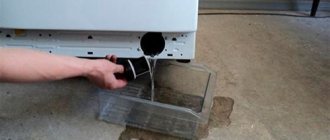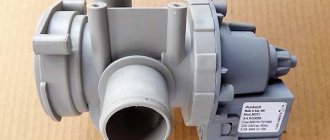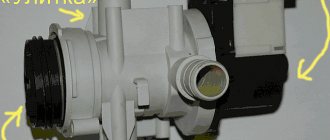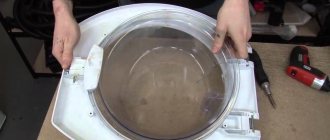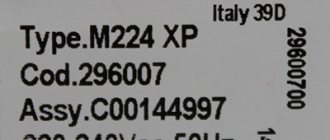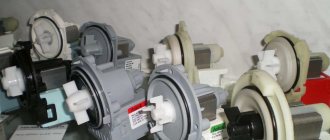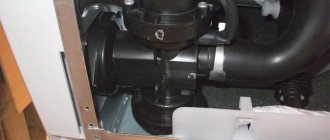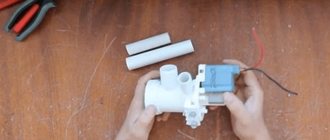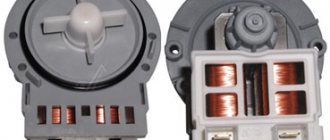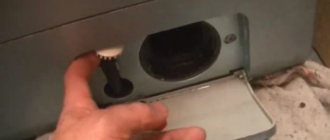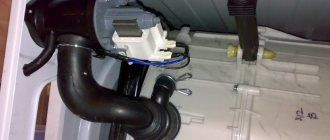The principle of operation of the washing machine
In modern automatic washing machines, water flows by gravity, that is, under water pressure from the tap to which the equipment is connected. Based on the software settings selected at the user’s discretion, the magnetic valve that allows water to pass through opens to allow the required amount of liquid into the working chamber.
The water level in the washing “drum” is controlled by a special sensor called a “pressostat”.
Passing through the detergent containers, the water mixes with them and enters the washing drum, where it remains throughout the entire washing process. When the washing is completed, the “waste” liquid flows through a special hose into the pump, which is present in the design of every automatic washing machine.
Heater
The heating element located inside the washing machine is responsible for heating the water during the washing process. The heater power most often ranges from 1800 to 2200 W. It is located at the bottom of the tank and is considered one of the most vulnerable elements of such equipment. Its breakdown is one of the most common and most often occurs due to the accumulation of scale on the surface of the heater.
Purpose of the pump
A typical solution includes an electric motor with an impeller and taps. On one side of the pump there is a pipe for liquid intake, and on the other there is a drain hose.
The main task of the device is to pump water into the system and then drain it at the command of the main processor. For example, in the rinsing mode, the machine requires a lot of liquid, while during the spin cycle it is completely useless.
If the pump is faulty, the processor will not be able to organize the normal operation of the modes, or the equipment will refuse to work at all. The design of the device cannot be called complex, as well as the principle of its operation. The vast majority of models have one of two solutions installed - drain or circulation.
Control block
This unit of the washing machine commands all other elements, so it can safely be called the “brain” of the device. It is also called a programmer, electronic board or control module. It is from such a block that commands are issued that are carried out by the fill system, heating element, drum, drain pump and other parts.
The control unit is the most complex and expensive part of the washing machine. Its device has a digital indicator, thanks to which the user knows everything about the operation of the device. In most models, if there is a malfunction, such an indicator begins to show an error code. Having learned its decoding, you can determine what the breakdown is and whether it can be dealt with without calling a technician. If the module itself fails, you should contact a specialist to repair or replace it.
Drain pump
Such devices are found mainly in budget and mid-budget technology. This is an ordinary pump pump that performs only one role - draining water into the sewer. In a good half of cases, the case is tightly sealed and cannot be disassembled. Therefore, it is more advisable not to repair it, but to buy a new one, since it is inexpensive.
The power of ordinary solutions fluctuates around 40 W. The device is secured to the frame either with plastic latches or with screws. The engine contact group has a separate or joint format.
One of the main disadvantages of a sump pump lies in the filter system. It often becomes clogged, water stagnates, and, as a result, unpleasant odors appear. Therefore, you have to constantly monitor the condition of the local filter and, if necessary, clean it or change it.
The operating principle of the drain pump is simple. Here we have a small-sized asynchronous motor working in tandem with a rotor and stator. The first includes a core, and the second includes a magnet with a winding. The design is quite simple: there are no high-tech solutions or complex circuits here, so it rarely fails.
The drain filter in the pump needs to be cleaned regularly.
What elements does the part consist of?
There is nothing complicated about the drain pump design. The pump rotor is a magnet made in the shape of a cylinder. It is “hidden” in a plastic casing. After starting the system, the rotor is activated first, then the impeller located on the shaft begins to rotate.
There is an insulating winding on the magnetic core. The design of the pump is similar to an asynchronous motor, which also has moving (rotor) and stationary (magnetic rod with winding) parts. This is how the pump functions. If any of its components are damaged, for example, the impeller impeller breaks, you will have to install a new pump. There is no point in repairing the part - it will only be a temporary measure.
The circular type pump also has a sealing collar. It serves to prevent water from pouring into the bearing assembly. These mechanisms are additionally equipped with a rotor shaft passing through a lip sleeve compressed by a spring ring. The standard SMA drainage pump is characterized by the following technical parameters:
- power – 25-40 Watt;
- placement of contacts: paired or separate;
- type of connection to the cochlea: screw or using snap fasteners.
If you need to replace the pump of an automatic machine, you need to buy a new part based on the characteristics of the old spare part. Otherwise, the purchased pump may simply not be suitable, and the money will be “thrown down the drain.”
Drain pumps for washing machines differ in power and location of contacts, as well as in the type of volute and the filter element placed inside them. Therefore, when selecting replacement components, be sure to focus on the model of your car. It is worth keeping in mind that if the garbage filter is clogged, the water may not leave the tank in full. Dirty fluid remaining in the system causes an unpleasant odor. To fix the problem, you need to clean out the trash can.
Cleaning the garbage filter is easy to do yourself. To do this, you need to turn off the power to the machine, turn off the water supply tap, and cover the floor around the washing machine with dry rags. The “plug” is located in the lower corner of the case, behind the decorative panel or technical hatch door. Unscrew the element from the machine, rinse in warm water, wipe the walls of the hole, remove the accumulated debris from inside and put the “spiral” back.
Circulation pump
This is a more complex design that ensures fluid circulation in the system. This format can significantly reduce water consumption. The main task of the circulation pump is to drive water only in one direction, that is, along a closed path. Such devices can work in tandem with a conventional drain pump, which significantly increases the efficiency of the entire structure.
Circulation pumps are equipped with equipment in the premium segment, less often in the mid-budget segment. Moreover, every well-known manufacturer tries to improve the device, introducing something new and useful. Thus, the Samsung brand included a seal in the design of the pump, which prevents water from escaping beyond the main circuit. Thanks to this solution, the bearings always remain dry, and this significantly increases the service life of the product. The company also uses a proprietary lubricant that eliminates most of the problems associated with rubbing mechanisms. As a result, the pump operates trouble-free for many years, while maintaining stable performance. Other brands have similar solutions.
Pump for Samsung washing machine
How to clean?
The cleaning process boils down to cleaning the impeller. A lot of garbage fibers are usually wrapped around it - wool, hair, threads. Procedure for disassembling the pump:
- Remove the casing - the snail by unscrewing the screws. In this case, you need to remember the relative position of the engine and the cochlea.
- Cleaning the filter is done using a wooden stick to remove dirt and scale. Wipe rubber elements with a slice of lemon.
- Unscrew the impeller with a screwdriver - unscrew the screws that connect the two parts of the pump to each other. Then you get to the impeller - the element that rotates during operation. Remove debris carefully to avoid breaking the blades. Wipe the inside of the snail.
- Reassemble the cleaned pump - assembly must be done in reverse order. To avoid mistakes, record your actions during disassembly - take a photo. Put all the parts in place and start the machine. If assembly is done correctly, there will be no leaks.
Pump location
The specific location of the pump depends on the type of equipment. The exact coordinates of the pump must be indicated in the diagram attached to the operating instructions. If the manufacturer allows the user to independently replace the pump, then its location is probably indicated in the “Maintenance” or “Service” section.
Possible pump location:
- Under the drum. One of the most common solutions in budget devices. To get to the pump, you need to remove the panel on the bottom, first laying the car on its side.
- At the rear of the structure. To remove the pump, you will need to move the equipment away from the wall and remove the back cover. Most often, the pump is located just below the centrifuge.
- Behind the front panel. In this case, it is enough to dismantle the bottom cover: snap off the clips or unscrew the screws.
The top location of the pump is unacceptable, because such a solution excessively loads the drainage system. In this case, the water would have to be pushed up at least a meter, which, taking into account the laws of physics, is inappropriate.
Pump replacement
If the pump cannot be repaired, it will have to be replaced. First, the part must be removed, which will require partially dismantling the housing.
How to remove?
An algorithm of actions that can be followed to remove the pump from a Bosch washing machine:
- To remove the pump, you need to unplug the machine and move it away from the wall.
- Then open the hatch located on the bottom front of the housing. This is done in order to drain the remaining water. Even if the drum is empty, some liquid is still retained in the nozzles.
- Then unscrew and remove the top cover, which is secured with 2 bolts.
- The next step is to remove the decorative panel at the bottom of the case.
- Under it you can see the bolt that holds the drain pump volute. It needs to be unscrewed.
- Then you need to fix the tank so that it does not break the wires when the machine is in a lying position. To do this, you can put a piece of cloth folded several times between it and the wall of the case.
- Turn the machine over and lay it on its side.
- Remove the bottom, disconnect the pipes from the volute and the power terminals.
- Unscrew the drain pipe to make sure that no foreign objects have gotten into it. If they are not found, the pipe is installed in its original place.
- The pump is attached to the volute with 4 latches; to remove it, you need to bend the locking terminal and then release the pump.
After removing the pump, you need to make sure that it is not working. This may be indicated by water getting on the impeller.
How to replace?
Installing a new pump does not involve any difficulties. The part is mounted in place of the old component.
Procedure:
- connect the pump to the drain and fill pipes, securing them securely;
- fix the pump in its original place;
- screw in the bolt holding the volute;
- return the machine to its original position;
- Assemble the body, tighten all bolts.
After completing the work, you need to check the tightness of the assembly. This can be done in a simple and effective way. Place a sheet of cardboard or dry light cloth under the bottom of the device, on which water stains will be visible.
Then all that remains is to turn on the machine, selecting the shortest wash cycle. If there are no leaks, household appliances can be used as before.
Bosch will tell you in a video about replacing the washing machine pump:
Operating rules
With proper care, an SMA pump lasts an average of 9-11 years. To prevent this period from being shortened, you must:
- ensure that the water is sufficiently clean (you must ensure that there are no foreign objects in the laundry pockets, and also remove pieces of dried dirt before washing);
- monitor the serviceability of filters;
- prevent the appearance of scale (for this it is recommended to use special water additives);
- Completely empty the tank upon completion of washing (wait until 100% of the water in the working tank has been pumped out).
It should be noted that if the pump does break, it is never repaired, but replaced with a new device. Moreover, this should only be done by a qualified specialist.
You may be wondering why the drainage of water into the SMA does not work.
Where and at what price can I buy it?
You can purchase a new pump in stores that specialize in selling original spare parts, or order it online.
When planning to make a purchase, you need to clarify the model of the washing machine, since the pumps will be different for different devices.
To buy a part that suits all parameters, you should count the number of fasteners, as well as find information about the power of the motor .
The cost of the motor depends on the model of the washing machine. The more modern it is, the more expensive the part is. The average cost of a pump for a Bocsh washing machine is 1,500 rubles. There are parts on sale at prices of 1200 and 1800 rubles.
Cost of replacement and repair
Since the Bosch washing machine has a complex device, technicians charge 2,000 rubles to replace the pump . If the pump can be repaired, then you won’t have to spend money on buying the part itself. However, you will still have to pay for the specialist’s work.
If the repair was entrusted to a private master, then you should choose the specialist who has positive reviews. An employee who values his reputation will be sure to provide a receipt for the work performed and give a guarantee for at least a year.
